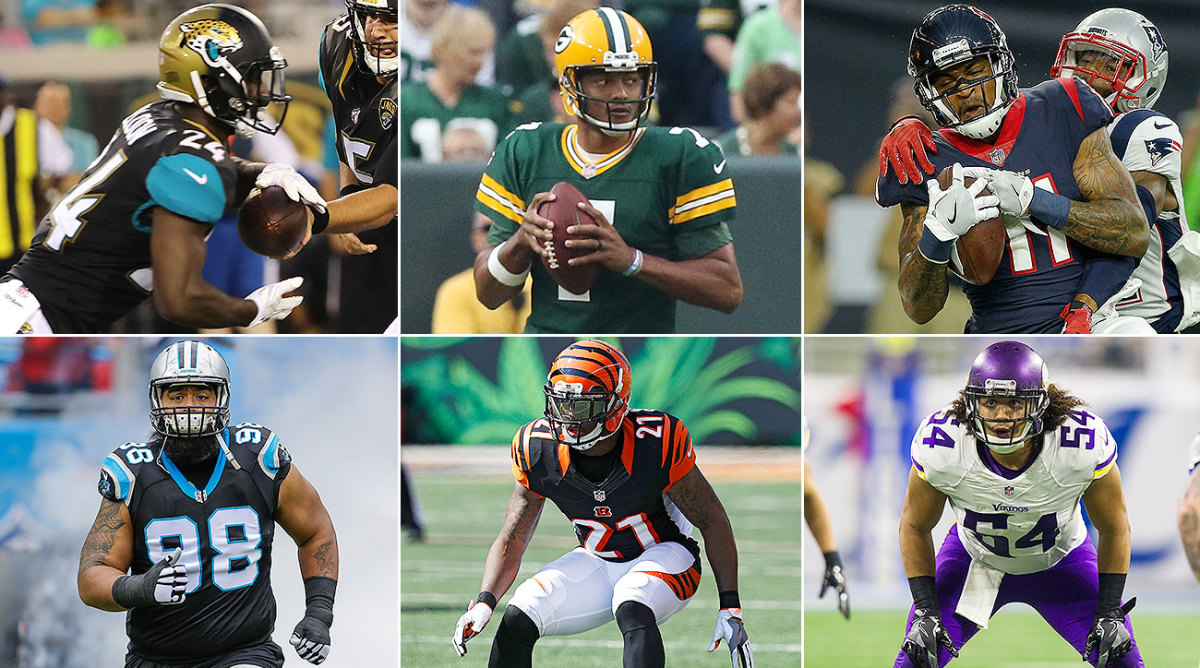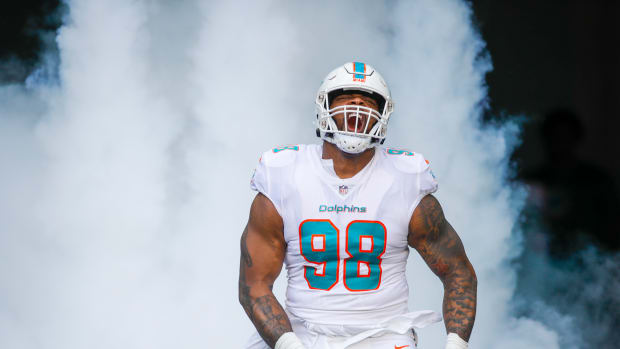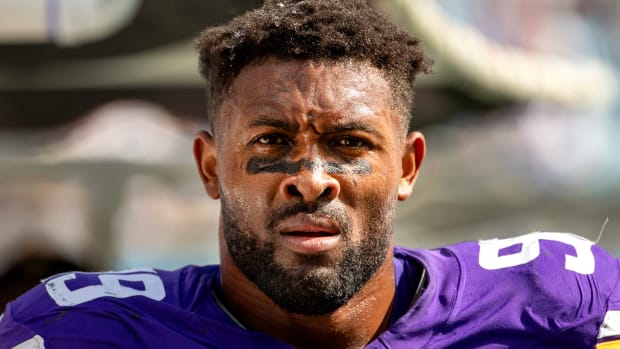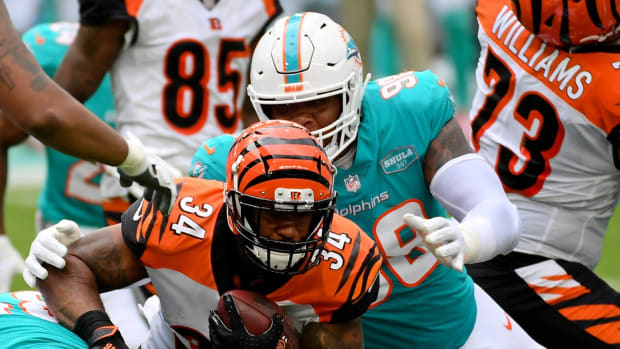Building an NFL Expansion Team: The Complete Draft
Our expansion franchise had to pick at least one player, but no more than two, off each current NFL roster (minus the keepers). If the franchise selected two players off the same roster, they had to come from different sides of the ball—one defense, one offense (or special teams); it could not, for example, select two Seattle wide receivers.
The post-draft roster includes 42 players, of varying contracts and NFL experience. It is, at first blush, a stronger outfit, on paper, than what the Texans cobbled together.
QB: Brett Hundley (Green Bay)
QB: Chase Daniel (New Orleans)
With Cincinnati's A.J. McCarron and New England's Jimmy Garoppolo both landing on the "protected" list in this exercise, the expansion-draft options at QB were limited. Nab a retread like Nick Foles, Matt Barkley or Ryan Mallett? Or roll the dice on a young, developing arm with intriguing upside?
The result here: a little from column A and a little from column B. The Packers reportedly shopped Hundley at this year's draft, only to keep him in place as Aaron Rodgers's backup. He's blocked from ever seeing the field there (assuming Rodgers stays healthy), but he also could receive the same boost in NFL circles that Tom Brady's backups have in the past—i.e. that playing behind a great, in a high-powered system, naturally makes QB2 better. Whether or not that's true, Hundley moves the needle more than any other expansion-available quarterback.
Helping to hold the down fort as Hundley settles in is Daniel, who has just two career starts under his belt but has seven seasons of NFL experience. With 11 open spots on the roster post-expansion draft, there's room to add a third quarterback, be it via trade or by sifting through the dust of free agency.
RB: T.J. Yeldon (Jacksonville)
RB: Rob Kelley (Washington)
RB: Darren Sproles (Philadelphia)
The Jaguars never fully trusted Yeldon as their every-down back, spelling him in short yardage as a rookie, then reducing his snaps via the additions of Chris Ivory (2016 free agency) and Leonard Fournette (2017 draft). Perhaps it's time for a fresh start. Even with the tempered role, Yeldon averaged 43 receptions and nearly 900 yards from scrimmage over his first two NFL seasons.
His style should pair well with the 233-lb., thunder brought by Kelley. As an undrafted rookie in Washington, Kelley rushed for 704 yards and six TDs, but Washington's keeper-list focus on its passing game and O-line squeezed him out.
Sproles is a wild-card selection, likely with but a year or two left in the tank. The choice for the third RB spot came down to he or Cincinnati's Gio Bernard, but adding the Bengals' Tyler Kroft at tight end eliminated the possibility of a Bernard selection. And despite his dwindling shelf life, Sproles remains a productive back, particularly as a pass catcher. The mix of backfield talent would allow our expansion team's offensive coordinator to play with combinations.
FB: Jalston Fowler (Tennessee)
The lone fullback on the roster, as the coaching staff figures out exactly what scheme it wants to employ. Fowler's a solid blocker, plus has the all-around game to be put to use in more ways than Tennessee saw fit.
WR: Chris Conley (Kansas City)
WR: John Brown (Arizona)
WR/KR: Deonte Thompson (Chicago)
WR: Jaelen Strong (Houston)
WR: Mohamed Sanu (Atlanta)
There are a handful of positions on this roster where the NFL's newest (imaginary) team appears quite competitive. There are others where it's obviously going to be a challenge to compete each week. The wide receivers fall under the latter category.
Talent exists here, of course, but who is the playmaker that really scares opposing defenses? Maybe Brown, if he's healthy, or Conley, if he breaks out free of Kansas City's attack. Strong has yet to emerge during his brief career, Sanu has proven himself to be a productive complementary receiver but no more, and Thompson's main role would be as a kick returner.
A note: Brown was chosen over current Cardinals teammate Larry Fitzgerald, whom the Arizona "front office" left exposed in a calculated gamble. Would Fitzgerald even continue playing if forced onto an expansion roster? The threat of his retirement was enough to push the focus onto Brown instead.
TE: Dwayne Allen (New England)
TE: Vance McDonald (San Francisco)
TE: Tyler Kroft (Cincinnati)
The ceiling is not all that elevated at tight end, but the bottom isn't going to fall out on the floor either.
Jack Doyle stole TE1 duties from Allen in Indianapolis, and Rob Gronkowski stood in front of him in New England. Still, he's shown that he can be an effective NFL tight end, if only in somewhat frustrating spurts. Neither McDonald nor Kroft has reached the same status; at least Kroft could have such production in him, provided with opportunity.
OT: Ty Sambrailo (Denver)
OT: Marcus Gilbert (Pittsburgh)
G: Chaz Green (Dallas)
G: Andrew Norwell (Carolina)
OL: JC Tretter (Cleveland)
C: Travis Swanson (Detroit)
OL: Denzelle Good (Indianapolis)
This would be far from the worst O-line in the league, which has to qualify as a win for an expansion club.
A plan to take George Fant (Seattle) fell apart when he injured his knee in preseason action—one could argue that shouldn't matter since this hypothetical draft would occur earlier in the calendar, but we have the luxury of a change here. So, it's Sambrailo as the initial starter on the left side, which isn't a great option but could buy time until the next full NFL draft. There is not another promising option for the blindside, although Tretter filled in for the Packers there a bit.
An interior of Green and Norwell at guard, with either Tretter or Swanson at center, certainly could hold its own. Norwell has been a very effective run blocker; Green is ticketed for a starting guard gig in Dallas' potent front.
DE: Owa Odighizuwa (NY Giants)
DE: Frank Clark (Seattle)
DT: Star Lotulelei (Carolina)
DT: Christian Covington (Houston)
DT: Chris Baker (Tampa Bay)
DE: Aaron Lynch (San Francisco)
Could have played this a lot safer, with more players of Baker's—weathered vets heavy on experience. What fun would that be? Baker, who will turn 30 this season, will have to serve as a father figure in the locker room.
He'll have a lot of promising talent there with him, led by Clark. Even with the Seahawks using the 10-player option in our draft, so they could protect seven defenders, Clark found himself squeezed out. Were this event to take place in reality, the Seahawks might look more aggressively at moving, for example, Richard Sherman so they could hang onto Clark. The young pass rusher isn't squeaky clean from a character perspective, but he did rack up 10.0 sacks a season ago.
Lynch notched 6.5 of his own during the 2015 campaign, before a suspension and then an injury cut into his '16. Our expansion club even could get Lynch, Clark and Odighizuwa on the field together, with Odighizuwa sliding inside on passing downs.
Would a Lotulelei-Baker-Covington rotation prove as fruitful as the regular tackles? The answer to that question would dictate how competitive this defense could be.
OLB: Shaq Barrett (Denver)
LB: Korey Toomer (LA Chargers)
LB: Eric Kendricks (Minnesota)
LB: Damario Davis (NY Jets)
LB: Ben Heeney (Oakland)
The challenge in trying to find viable, starter-caliber defenders through this expansion draft is that it's tough to piece them all together in a scheme, at least on paper. Davis is best suited for a 3–4 inside LB role, Barrett as a stand-up off the edge. Could the former play either the middle or weakside in a 4–3? Could the latter be an every-down LB or would he have to be saved for passing situations?
Kendricks would have to be the star of this group, likely slotting into the middle as he has with the Vikings. Pushing him out to a weakside role so Davis, Heeney or Toomer could plant inside could be an option, too. Both Toomer and Heeney have flashed against the run during their careers.
The front seven has a mix-and-match feel. Save for Kendricks, Clark and possibly Baker or Davis, there are no clear standouts.
CB: Darqueze Dennard (Cincinnati)
CB: PJ Williams (New Orleans)
CB: Brian Poole (Atlanta)
CB: Bobby McCain (Miami)
CB: Ladarius Gunter (Green Bay)
The slot should be under control—both Poole and McCain have done well there. It's outside, matched up against an opponent's top receivers, where this unit would have to prove its mettle. One of Dennard, Williams and Gunter would stand to be the No. 1 guy, and all three are at the stages of their careers where they're still fighting to prove they can be No. 2s.
S: Lamarcus Joyner (LA Rams)
S: Duron Harmon (New England)
S: Jordan Poyer (Buffalo)
Maybe the most solid of the defensive units. All three players have starting experience, and Joyner's ability in coverage might even allow this D to roll out a host of three-safety looks. This will have to be an area where depth is added post-draft, and there doesn't figure to be a whole lot available there.
K: Greg Zeuerlein (LA Rams)
P: Sam Koch (Baltimore)
Decent kicker. Good punter. Check.





































